ASUS UL80Vt First Look: Mobility Redefined
by Jarred Walton on October 24, 2009 8:00 PM EST- Posted in
- Laptops
ASUS UL80Vt Benchmarked - General Performance
This is a first look and we have not yet had a chance to run all of our performance tests. Battery life testing in particular is going to take a long time -- which is a good thing, outside of the testing aspect. We have only had the UL80Vt for two days now, but we have been duly impressed with its features, design, and performance. It may not be the best-looking laptop on the planet, it may not have every feature under the sun, and it certainly isn't the fastest laptop. However, it does everything a typical laptop user could need, it does it at an affordable price point, and it truly manages to redefine what we can expect in terms of mobility from Windows laptops. Here are a few preliminary benchmarks we've run.
We conducted tests using the "moderate battery saving" and "maximum performance" profiles in ASUS' Power4Gear software. Turbo mode (overclocking) was enabled in all testing so far; honestly, we don't see much point in disabling it (which requires a reboot), but we'll test battery life without Turbo mode for the full review; that may add another 5-10% battery life, although the laptop already lasts a full day so it's not a critical concern. The SU7300 CPU has two P-states, 800MHz and 1300MHz; the overclocked FSB results in the SU7300 running at 1066MHz or 1733MHz (using a 4X or 6.5X multiplier). CPU-Z does not report clock speeds correctly (it always showed an 8X multiplier for some reason), but ASUS provided an updated version of Intel's Thermal Analysis Tool that reports the correct speed.
After a few initial tests, we discovered that the only way to get the CPU to run at the 6.5X multiplier is to select "Maximum Performance" in the Power4Gear software, with the maximum CPU speed set to at least 62%; otherwise the CPU will always run at the 4X multiplier. Since we already had a bunch of results for 1066MHz, we decided to report those -- it will make for an interesting comparison with the Intel Atom at least. The 1733MHz results will be in bright green and the 1066MHz results are in dark green in the following charts. We'll start with general performance results using PCMark as well as a few CPU intensive tasks like video encoding and 3D rendering.
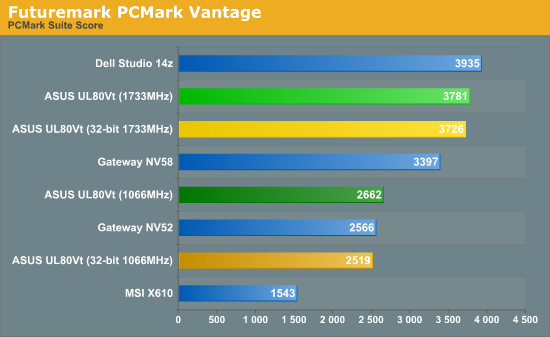
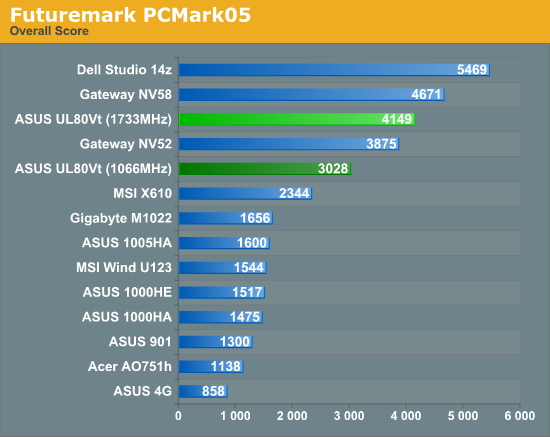
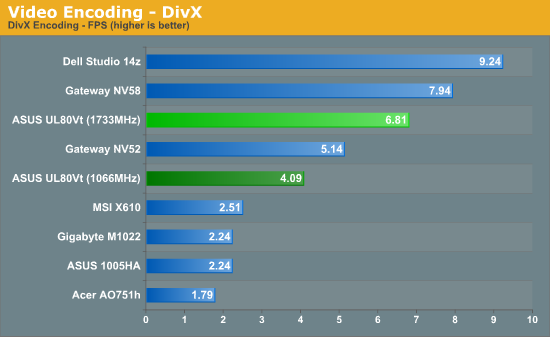
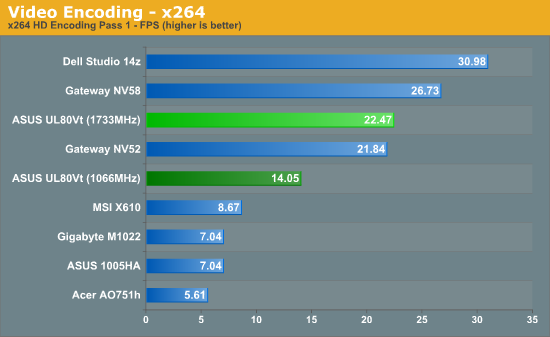
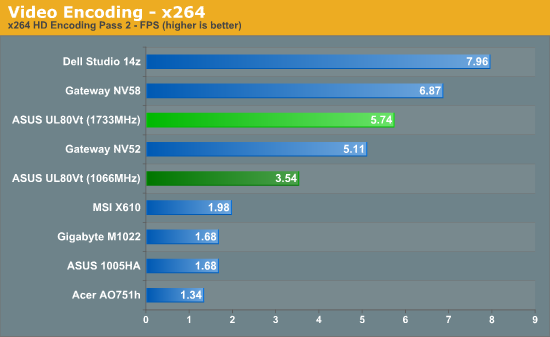
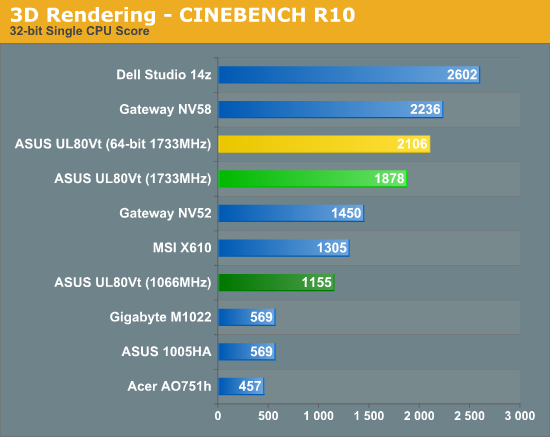
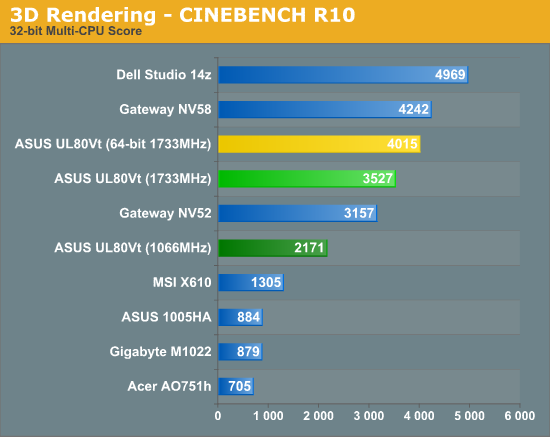
The general performance delivered by the UL80Vt is certainly impressive. It's not the fastest laptop on the market by any means, but application performance is better than the majority of AMD-based laptops currently available. The overclocked SU7300 outperforms the Athlon QL-64 (2.1GHz) by 7% in PCMark05, 47% in PCMark Vantage, 12% in the second x264 encoding pass (the first pass is relatively simple by comparison, depending more on the hard drive and platform than on the CPU), 32% in DivX encoding, and 12% in CINEBENCH R10. The latest 45nm AMD parts like the Turion II Ultra M640 will regain the lead, certainly, but we still have to account for power draw. We'll get to that in a moment, but suffice it to say that it's going to be difficult to beat the overclocked SU7300.
Comparing the UL80Vt to netbooks shows just how slow the Intel Atom is. Even at 1066MHz, the UL80Vt is typically at least twice as fast as the ASUS 1005HA, and at 1733MHz it's 150-250% faster. Sure, it also costs twice as much, but we would make a strong argument that netbooks are only "fast enough" if your demands are low. The bigger selling point for netbooks is their small size and weight, and 14" laptops costing close to $800 certainly encroach on that territory. Netbooks work far better as a second (or third…) PC than as your primary system, while something like the UL80Vt can fill all roles reasonably well. If the general application performance makes netbooks look bad, wait until we look at graphics performance.










100 Comments
View All Comments
feelingshorter - Sunday, October 25, 2009 - link
We understand that it takes a long time to test the battery. Just wanted to know that you are working on it for the final review. Thanks :)CurseTheSky - Sunday, October 25, 2009 - link
I just bought a UL30A-A2 on Thursday. It's a wonderful laptop, though not quite perfect.Unlike the ULxxVt laptops, the non-Vts come with just the X4500MHD, which is abysmal for anything other than general web browsing and watching movies. While I love the smallness of my 13.3", if I had read sooner than the UL80Vt comes with on-the-fly switchable graphics, I probably would have bought it instead. Oh well. Additionally, as far as I know the entire UL series also lacks Bluetooth, which kind of sucks. ASUS stated somewhere (one Amazon, I believe) that they're considering bundling a USB Bluetooth dongle.
Anyway, what was said in this article about the build quality is very true. It's sort of a mixed bag, but overall much better than most of the competition. The brushed aluminum cover is a very nice touch, and the plastic palm rest doesn't feel all that bad. The glossy black around the LCD is annoying (adds extra glare and really attracts finger prints), but the hinges really feel solid and the keyboard is excellent. The trackpad is a bit odd, but I find that I actually like it. Don't expect a Macbook Pro / Air in terms of fit and finish, but do expect something that'll get your friends or the locals at Starbucks asking "What's an ASUS?" and "That's nice, where did you get that?" Best of all, it doesn't cost as much as a Macbook Pro.
Really, the best part of these things is the battery life. Several reviews I've read have clocked around 8-9 hours real-world performance (ASUS claims 16 on my particular model, and the consensus seems to be that 12-13 wouldn't be unreasonable in a best-case scenario). I can't wait to read the Anandtech follow-up; I've always loved their testing methodology. The thinness and lightness of the series - particularly the smaller models - is also a huge plus.
Overall, great article, and great laptop. For anyone that values portability over performance but still wants something that'll fair (much) better than a netbook under stress, I highly recommend the UL series. Nice job ASUS.
Gooberlx2 - Monday, October 26, 2009 - link
http://www.amazon.com/UL30vt/forum/Fx1978M98LGJ2GT...">http://www.amazon.com/UL30vt/forum/Fx19...mp;store...Maybe the UL30vt will be available stateside some time in December?
I don't really put too much stock in to forum postings from sources one can't really verify. But since I won't have any $$$ until at least after the New Year, I'm certainly hoping it's true.
Uncreative - Sunday, October 25, 2009 - link
I've been watching this one ever since you guys posted the first look on the UL50VT. I've been looking to buy a laptop for class and a one day charge to last me through lecture and a good couple hours at the library would be perfect. I'm definately with you on the panel, I'd gladly pay more for a better LCD.I saw that they had the SU9400 listed as one of the possible models, was wondering if anyone has any idea when/if that model is coming?
Drizzt321 - Sunday, October 25, 2009 - link
Wow, I've have been wanting to find a laptop with one of the ULV Intel processors that doesn't cost an arm and a leg. Add to that the switchable graphics, and decent cost, and I think I've found my winner! Except, of course, the LCD. I'd like to do some graphics work (digital photography) on the go, and a good quality panel would be very nice. Hell, just give me a nice TN panel with this laptop and I'll be good. Give me an IPS/MVA/PVA panel and I'll be in heaven. For one of those good panels, I'd happily pay an extra $150-$200. Do you hear that Asus? There are people willing to pay for quality!dtham - Monday, October 26, 2009 - link
This is very ideal for schoolwork etc. I would love to see one that has a touchscreen display for taking notes, etc.The downside to the touchscreen is that it will be likely to have an even worse screen. However, with battery life for light work like this it would be absolutely awesome for students.
JarredWalton - Monday, October 26, 2009 - link
Ugh... I hate touch screens. I can type at 60 WPM, or chicken scratch at about 20 WPM (okay, maybe 30?) Anyway, you can get the Acer Aspire 5738PM with a touch screen, but that has worse battery life and it's not a tablet. I wouldn't buy a touch screen, though, unless things were much better than the last time I used one.chrnochime - Sunday, October 25, 2009 - link
At a higher price of 1.5k, manufacturers KNOW they can better justify adding that option, since people paying that much for laptop are much more willing to pay a bit more for PVA than those at the 820 USD price.Consider this: 200 for a panel option on a laptop that costs 820. That's almost 25% increase. Versus 200 on a 1500, which is ~13.4%. Latter case much more acceptable to buyer when taking original price into account.
munim - Sunday, October 25, 2009 - link
Dude: Hey is that a Macbook Air?Dudette: No, it's an ASUS UL80Vt
Dude: You'll what?
san1s - Saturday, October 24, 2009 - link
this looks great, and it has an optical drive. I wonder if there's any way to get it past 1.7 ghz?